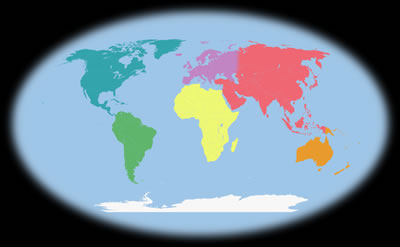The surface of the Earth is divided between the continents and the ocean basins.
Continental crust is lighter than oceanic crust and, on average, continents are about 2.8 miles (4.5 kilometers higher than ocean basins).
Continents began to form on Earth almost 4 billion years ago, when ocean covered the newly formed Earth. Scientists think they were created by the collisions of tectonic plates. One plate, consisting of oceanic crust, would slide beneath another plate, or subduct. It would then fall into the mantle, melt and become magma. This magma, which was lighter than the original oceanic rock, rose out of the crust as lava. When the lava cooled, it became igneous rock. This igneous rock formed small islands. Over time, these islands grew larger and eventually fused together to become continents.

The continents we know today have not always existed on Earth. Because of plate tectonics, old continents are constantly breaking apart and new continents are constantly forming.
Continents contain interiors, which are large, flat regions, mountain belts and coastal plains.
Continental interiors are stable regions that have been undisturbed for at least 600 million years. They contain shields, broad flat regions made up of highly deformed crystalline rocks. Rock samples indicate that shields can be between 1 billion and almost 4 billion years old. The oldest of these rock samples were once subjected to enormous levels of heat and pressure. This indicates that they used to be part of mountain chains that have since eroded.
Examples of shields include the Canadian Shield in North America, the Amazonian Shield in South America and the Baltic Shield in Northern Europe.
A platform is another feature of a continental interior. Platforms also contain highly deformed rocks, this time covered with a thin layer of sedimentary rock
Mountain belts, located near continental margins, consist of highly deformed, uplifted rocks. The youngest mountain belts tend to be located either in a region surrounding the Pacific Ocean known as the Ring of Fire or in the Alpide belt, a region that extends from the Alps through the Himalayas and then to Indonesia. These regions are very active geologically and experience frequent earthquakes. They contain mountains that are less than 100 million years old.
A coastal plain is a low, flat area of land at the continent’s edge that is separated from the interior, usually by mountains. It may once have been part of the continental shelf, a submerged, sloping region surrounding the continent. When sea levels fall, part of the continental shelf is exposed, and the exposed section becomes a coastal plain.
Coastal plains may also be created from sediment. When a river flows toward the ocean, it carries sediment with it. This sediment builds up along the edge of the continents.